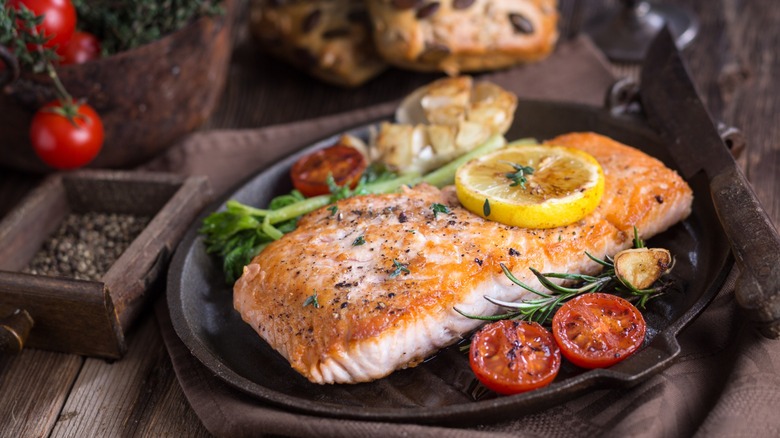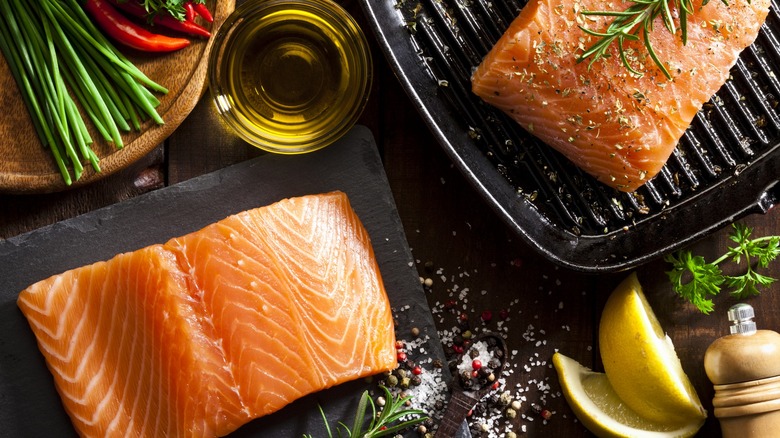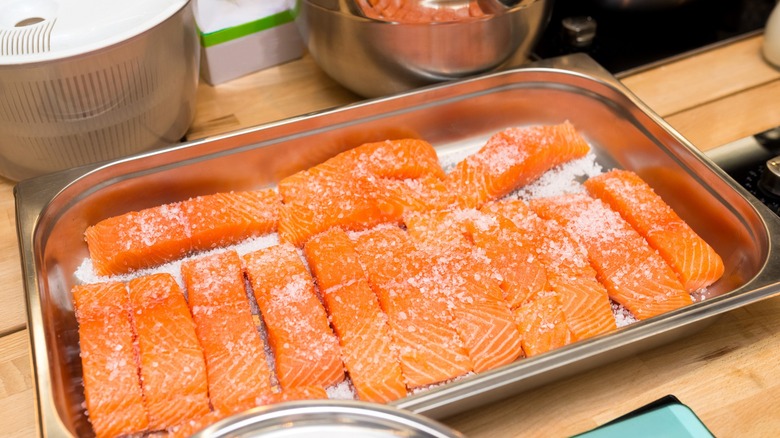How To Cook Salmon So It Doesn't Leak White Goo
If you've hungrily tried to cook a salmon dinner but lost your appetite when you saw that white ooze leaking out, don't be alarmed. It's just a natural protein called albumin that the fish sweats out when it heats up, and even though it looks a little gross, it's completely harmless. Still, it's not the most aesthetically pleasing sight to look at when eating your dinner, and too much of it is usually a sign that you're overcooking and drying out your salmon, anyway, so it's understandable if you want to avoid it. Luckily, you can prevent the goo from seeping by cooking your salmon over a lower flame, skin-side down.
There's no way to avoid the presence of albumin inside salmon. It's just always going to be there — whether your salmon is wild or farm-raised, Pacific or Atlantic. In live salmon, albumin exists in a liquid state, but muscle fibers push the stuff to the surface of the fish when they're heated up. There, the protein coagulates and turns more solid, usually a sign that the salmon is done cooking, and it's time to take the fish off of the heat.
Avoiding albumin
Although albumin can pop up at any point, it usually starts pooling the most when a piece of salmon is cooked too fast and too hot. Salmon dries out easily, and the ideal temperature to cook it through is medium heat. Letting the salmon sit at room temperature for at least 15 minutes is also an effective way of making sure the fish will cook nicely at a low and slow rate. Similarly, pat it dry before you toss it on the heat to avoid extra moisture.
If you want to sear salmon or, during the summertime, grill it over an open flame, be sure to leave the fish skin-side down. Not only will this protect the rest of the piece from overheating, but it will also leave the skin crispy and delicious instead of chewy and rubbery. Flip it over at the end for a quick sear, and you have yourself a salmon that's ready to serve, most likely free of too much of that uncouth albumin.
The beauty of brining
There's another way to prevent your salmon from leaking white goo, only this time it requires a bit of pre-cooking preparation. Placing your salmon back in salt water, as if you're briefly returning it back to the sea, will tenderize the muscle fibers, so they don't tighten up and push the albumin to the surface. This also has the benefit of softening the texture of your salmon, as well as giving an evenly coated distribution of salt.
A nice ratio to use is one tablespoon of salt per cup of water — with a soaking time of about 10 minutes. You can also add sugar to the mixture for some sweetness and browning — while dry brining without water also works perfectly fine if you add an extra five minutes or so to the time. After all this work, if you do get a bit of albumin on the top, you can always just scrape it gently off with a fork or knife. Believe me, it looks fishier than it tastes.



